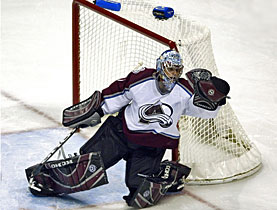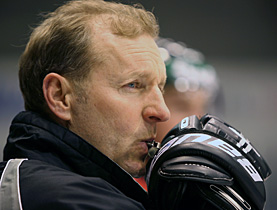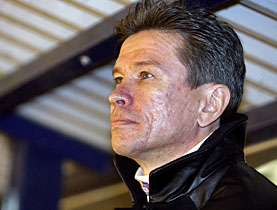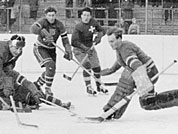Learning to catch a better technique

Switzerland has a reputation as a "factory" for ice hockey goalies, but while many net minders are effective from the waist down, their gloves let them down.
To try to solve the problem, Marco Baron, a former goalie in the National Hockey League (NHL), took some hints from a different sport – baseball.
“It’s interesting to observe the goalies’ moves during warm-up,” says the Swiss-Canadian, now a coach and television commentator.
For fans, the game begins the second the referee drops the puck, but for Baron, who made a career playing in North America’s top league, the curtain goes up a few minutes earlier.
“What used to happen was that the player who performed least brilliantly went in goal. I remember seeing several overweight players in goal when I was in America,” He said.
But, for some years now, the goalie has actually been one of the fittest players in the team.”
Exporting goalies
Ranked seventh by the International Ice Hockey Federation at the end of 2008, Switzerland has gained respect in the hockey world, and not just based on its results in international play.
The Swiss also enjoy an excellent reputation for goalie training. Foreign teams, especially those in North America, look for Swiss goalies more than they do for players in other positions.
Following the trail blazed by Pauli Jaks, who in 1993 became Switzerland’s first goalie to play in the NHL, a number of players have opted for a transatlantic career.
Right now, four Swiss goalkeepers are doing the rounds in North American clubs: Jonas Hiller of the Anaheim Ducks, Martin Gerber of the Toronto Maple Leafs, Tobias Stephan of the Dallas Stars and its minor league affiliate and Daniel Manzato of the Albany River Rats, a team in the American Hockey League (AHL).
“There are plenty of reasons why Swiss goalkeepers perform well. The main one, in my opinion, derives from the type of hockey played on Swiss rinks. It’s a much more open game, with less tight defensive cover than in North America,” explaned Baron. “So goalkeepers in Switzerland have a busier time.”
Many goalies, few teams
“This peculiarity became very clear during the [2004-05 NHL] lockout,” added Baron.
“Swiss goalies Patrick Aebischer and Martin Gerber belonged to NHL clubs at the time. When they temporarily returned to Switzerland, they were clearly struggling to perform their best. With a looser defence, they were unable to concentrate purely on the shots and let in a lot of dangerous rebounds,” Baron recalled.
Apart from a lack of defensive strength, more work needs to be done to provide opportunities for young players. “Examples who come to mind are Leonardo Genoni, who became the Davos goalie at 21, or Lukas Flüeler of Zurich, who is 20,” said Baron.
Baron thinks more could be done developing talent. “If there were more teams in Switzerland we could offer openings to young goalkeepers who have not won their spurs but do have great potential.”
“Or we could set an age limit for goalkeepers in the B series and only allow under-25s on the ice,” he muses.
From a technical standpoint, Baron says there is room for improvement in how Swiss goalies use their catching glove. Swiss goalkeepers are much more accustomed to sports such as football. So, unlike their American colleagues, they have developed no instinct for moving hands and arms in synchronisation.
Legs
“As a goalkeeper who grew up in America, the home of baseball, I find it natural to use the glove. When I was a child, I used to wear baseball mitts for several months of the year. I got used to catching balls coming from right and left, low and high,” Baron said.
He notes that the Russian goalkeepers are also mediocre glove users. In the 1970s and 1980s the goalkeepers of the former Soviet Union were famous above all else for using their pads.
One example was Vladislav Tretiak, who Baron believes is one of greatest goalies of all time. “When I saw film clips of his really tough training sessions, they reminded me of [Sylvester Stallone’s boxing character] Rocky training in Russia.”
“Summer baseball camps could be very useful for Swiss goalies too,” Baron said.
Flawless
Looking ahead to the world tournament in April and May, Baron is already confident about the form of one of his own heroes.
“The greatest player between the posts is certain to be Martin Brodeur of Canada,” he said.
On March 17, Brodeur recorded his 552nd regular season victory, surpassing Patrick Roy’s record to become the NHL’s all-time leader in regular season wins by a goaltender.
“When he steps on to the ice everyone wonders when will he make a mistake. He won’t. Brodeur remains impeccable.”
And who are Baron’s favourite goalies in Switzerland? “I like Kloten’s Ronnie Rueger very much because unlike other players, he has a winning mindset. I also admire Gerber, and Hiller is a reliable guy who believes in his abilities.”
“Putting the clock back,” he reminisces, “I have glorious memories of Olivier Anken, of Biel, and of the legendary Alfio Molina, possibly the first Swiss goalkeeper to receive an offer from America.”
And future stars? “I think we’ll be hearing a lot about certain young talents in the next few years. They include Damiano Ciaccio, the 20-year-old goalkeeper of Italian origin now with Fribourg, and Benjamin Conz, a 17-year-old from Geneva-Servette.”
swissinfo, based on an article in Italian by Luigi Jorio
Son of an Italian who emigrated to Canada, Baron was born in Montreal, Quebec, on April 4, 1959.
Baron made his NHL debut in 1979 with the Boston Bruins.
He played for Boston, the Los Angeles Kings and Edmonton Oilers and in the AHL.
Baron won the Swiss championship with Ambri Piotta in 1985.
Since retiring, he has trained goalkeepers and Ticino youth teams and has been a television commentator.
Before 1970, an ice hockey goalie’s equipment weighed about 25 kg – ten kilograms more than today.
Over time lighter and stronger synthetic materials have superseded leather and horsehair.
Apart from a jock strap and stick, to go out on the ice a goalkeeper needs: a helmet (the only customised item of kit), a catch glove (similar to a baseball glove), a blocker glove, shin pads and neck guard.
The cost of the kit ranges from SFr3,000 ($2,500) to SFr18,000.

In compliance with the JTI standards
More: SWI swissinfo.ch certified by the Journalism Trust Initiative





You can find an overview of ongoing debates with our journalists here. Please join us!
If you want to start a conversation about a topic raised in this article or want to report factual errors, email us at english@swissinfo.ch.